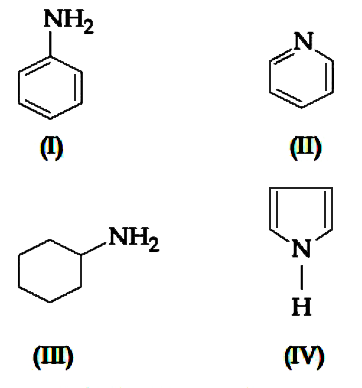The order of decreasing nucleophilicity of the following is
The correct Answer is:B
To determine the order of decreasing nucleophilicity among the given nucleophiles: H2O, OH-, CH3COO-, and CH3O-, we need to analyze the structure and electron availability of each nucleophile.
1. Identify the Nucleophiles: The nucleophiles given are:
- H2O (water)
- OH- (hydroxide ion)
- CH3COO- (acetate ion)
- CH3O- (methoxide ion)
2. Understand Nucleophilicity: Nucleophilicity refers to the ability of a species to donate an electron pair to an electrophile. Generally, the more available the electron pair is, the stronger the nucleophile.
3. Compare OH- and H2O:
- OH- has a negative charge, which means it has an extra lone pair of electrons compared to H2O. This makes OH- a stronger nucleophile than H2O.
- Conclusion: OH- > H2O
4. Analyze CH3O- (Methoxide Ion):
- CH3O- has a negative charge on the oxygen, similar to OH-. Additionally, the methyl group (CH3) is an electron-donating group due to its +I effect, which increases the electron density on the oxygen and makes the lone pair more available for nucleophilic attack.
- Conclusion: CH3O- > OH-
5. Consider CH3COO- (Acetate Ion):
- In CH3COO-, the negative charge is delocalized between the two oxygen atoms due to resonance. This delocalization reduces the availability of the lone pair for nucleophilic attack, making it a weaker nucleophile compared to OH- and CH3O-.
- Conclusion: CH3COO- < OH- and CH3O-
6. Final Comparison:
- Based on the above analysis, we can summarize the nucleophilicity order as:
- CH3O- > OH- > H2O > CH3COO-
Final Order of Decreasing Nucleophilicity:
CH3O- > OH- > H2O > CH3COO-
- H2O (water)
- OH- (hydroxide ion)
- CH3COO- (acetate ion)
- CH3O- (methoxide ion)
- OH- has a negative charge, which means it has an extra lone pair of electrons compared to H2O. This makes OH- a stronger nucleophile than H2O.
- Conclusion: OH- > H2O
- CH3O- has a negative charge on the oxygen, similar to OH-. Additionally, the methyl group (CH3) is an electron-donating group due to its +I effect, which increases the electron density on the oxygen and makes the lone pair more available for nucleophilic attack.
- Conclusion: CH3O- > OH-
- In CH3COO-, the negative charge is delocalized between the two oxygen atoms due to resonance. This delocalization reduces the availability of the lone pair for nucleophilic attack, making it a weaker nucleophile compared to OH- and CH3O-.
- Conclusion: CH3COO- < OH- and CH3O-
- Based on the above analysis, we can summarize the nucleophilicity order as:
- CH3O- > OH- > H2O > CH3COO-
CH3O- > OH- > H2O > CH3COO-
Topper's Solved these Questions
- ALKYL AND ARYL HALIDEBOOK - ALLENCHAPTER - ALKYL AND ARYL HALIDEEXERCISE - EXERCISE-02
1 Videos
- ALKYL AND ARYL HALIDEBOOK - ALLENCHAPTER - ALKYL AND ARYL HALIDEEXERCISE - EXERCISE-04 [A]
1 Videos
- ALKYL AND ARYL HALIDEBOOK - ALLENCHAPTER - ALKYL AND ARYL HALIDEEXERCISE - EXERCISE-01
1 Videos
- ALKENE, ALKANE & ALKYNE BOOK - ALLENCHAPTER - ALKENE, ALKANE & ALKYNE EXERCISE - EXCERSISE-3
28 Videos
- Atomic StructureBOOK - ALLENCHAPTER - Atomic StructureEXERCISE - All Questions
62 Videos
Similar Questions
Knowledge Check
The order of decreasing nucleophilicities of the following species is :
ACH3ΘS>CH3ΘO>CH3COΘO>CH3OHBCH3COΘO>CH3ΘS>CH3ΘO>CH3OHCCH3OH>CH3ΘS>CH3COΘO>CH3ΘODCH3ΘO>CH3OH>CH3COΘO>CH3ΘSRank the following species in order of decreasing nucleophilicity in a polar protic solvent (most → least nucleophilic):
 A3 gt 1 gt 2B2 gt 3 gt 1C1 gt 3 gt 2D2 gt1 gt 3
A3 gt 1 gt 2B2 gt 3 gt 1C1 gt 3 gt 2D2 gt1 gt 3
The decreasing nucleophilic order of the following compounds is:
i. NH3, ii. PH3, iii. AsH3, iv. SbH3
View SolutionThe decreasing order of nucleophilicity for the folllwing anions is
CH3CO−2,CH3O−,C6H5O−,NO3
View SolutionThe decreasing nucleophillic order fo the following compounds is:
i. Fo−, ii. Clo−, iii. Bro−, Iv. Io−
View SolutionWhat is the correct order of decreasing nucleophilicity in non-polar solvents: OH−,NH−2,F−,CH−3
View SolutionThe decreasing order of basicity of the following amines is :

View SolutionOrder of nucleophilicity is
View Solution
